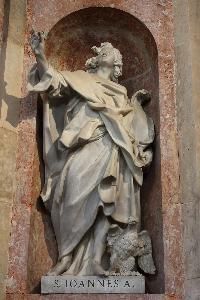Johannis Baptistae Vacca
Giovanni Battista Vacca;Johannis Baptistae Vacca
สถานที่: Rome
เกิด: 1688
ความตาย: 1745
ชีวประวัติ:
Johannis Baptistae Vacca, also known as Giovanni Battista Vacca, was an Italian artist born in Rome in 1688 and died in 1745. He was a sculptor who created the Statue of St. John the Evangelist in 1733.
Early Life and Training
Vacca's early life and training are not well-documented, but it is known that he was active in Rome during the 18th century. He was likely influenced by the Baroque style of the time, which emphasized dramatic lighting and intense emotions.
Artistic Style and Notable Works
Vacca's artistic style is characterized by his use of chiaroscuro, a technique that uses strong contrasts of light and dark to create a sense of volume and depth. His most notable work, the Statue of St. John the Evangelist, showcases his skill in capturing the subtleties of human emotion.
- Statue of St. John the Evangelist: This sculpture is a prime example of Vacca's ability to convey complex emotions through his art.
- Museum San Giovanni Decollato: This museum in Rome features several works by Vacca, including his Statue of St. John the Evangelist.
- Oratory of San Giovanni Decollato: This oratory is home to Mannerist frescoes by Francesco Salviati, Jacopino del Conte, and Pirro Ligoria.
Influence and Legacy
Vacca's work had a significant influence on the development of Italian art in the 18th century. His use of chiaroscuro and his ability to capture complex emotions have been studied by artists for centuries. Notable artists who have been influenced by Vacca include Maurizio Savini, Michelangelo Buonarroti, and Giulio Aristide Sartorio. Their works can be found on Giovanni Battista Vacca, a platform that showcases the work of various artists from around the world.
Conclusion
Johannis Baptistae Vacca was a talented artist who made significant contributions to the development of Italian art in the 18th century. His use of chiaroscuro and his ability to capture complex emotions have been studied by artists for centuries, and his legacy continues to be celebrated through his works on Statue of St. John the Evangelist.

